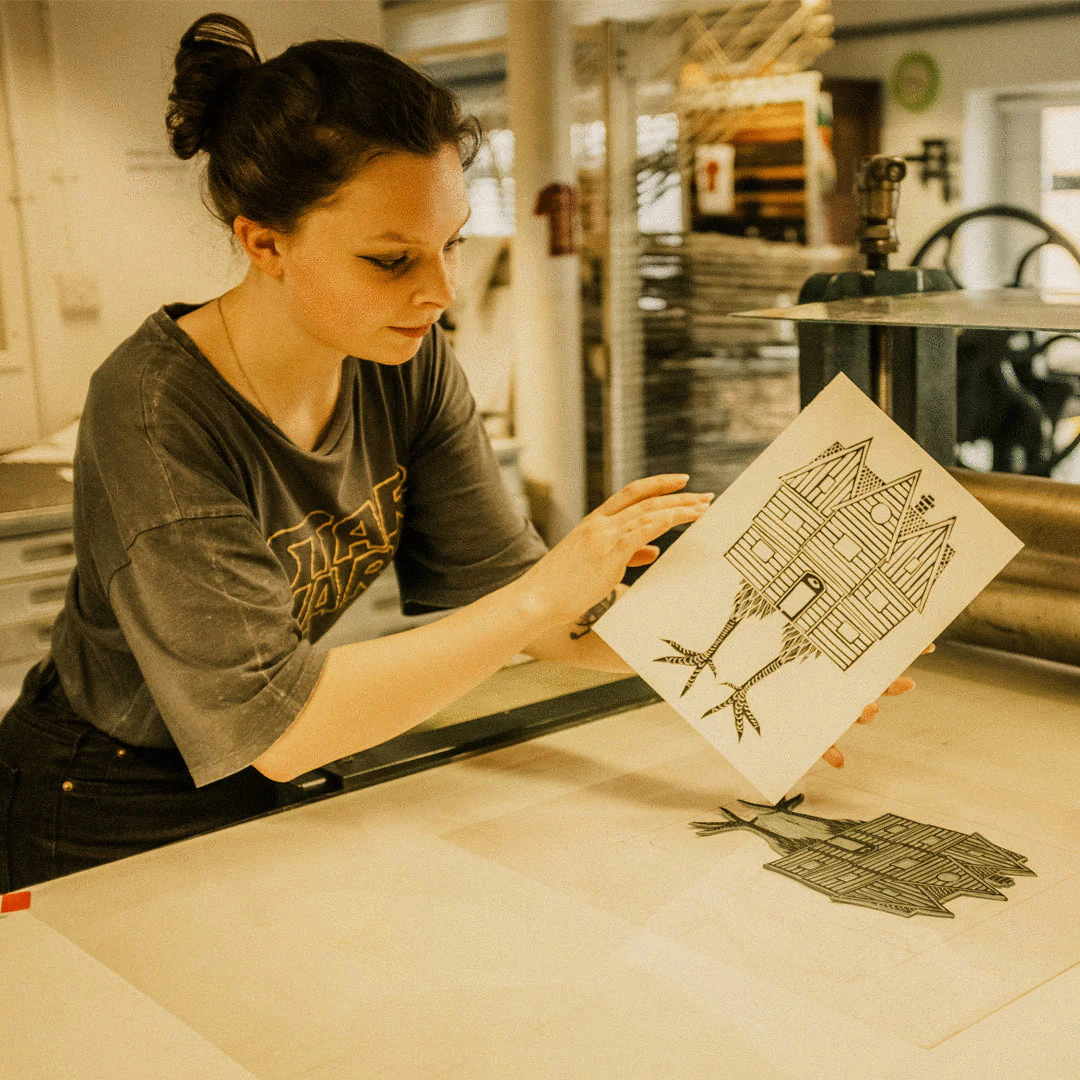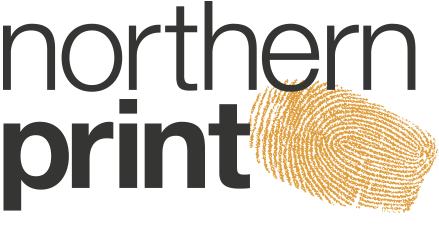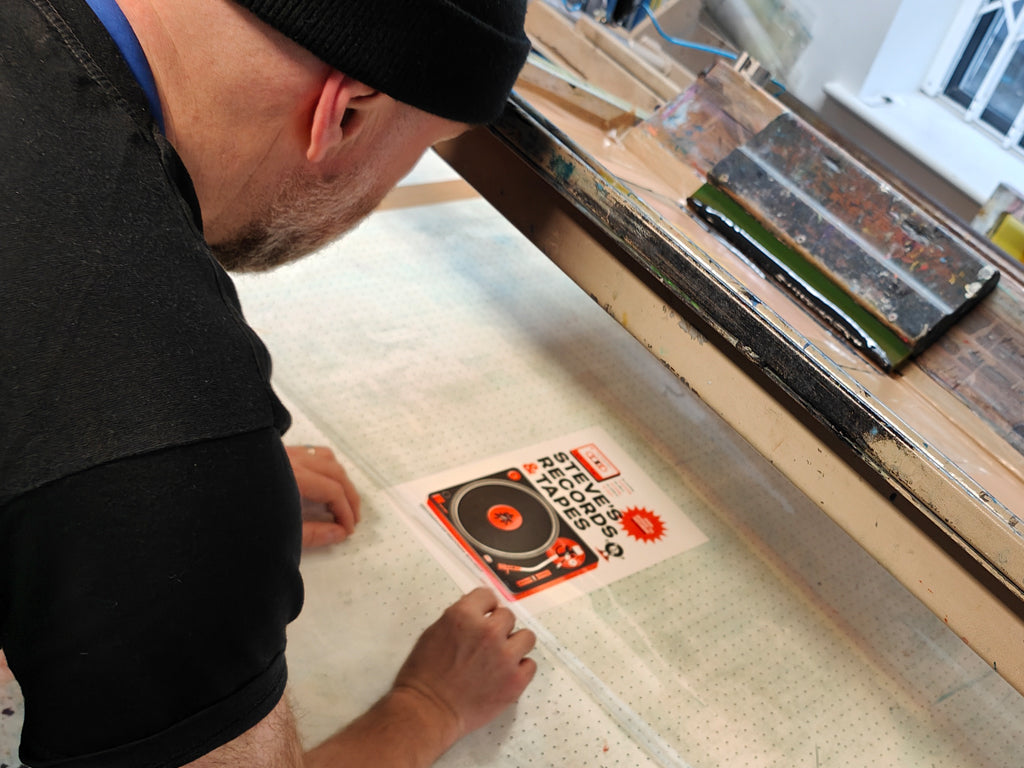
Studio News: Edition 5: 24 April 2020
Share
 Welcome
Welcome
We’re already on to Edition 5 of our weekly newsletter and hope you have manged to follow some of the links and discovered new websites, artists or ideas or perhaps been reminded of old favourites. As promised this week we are taking woodcut as our starting point with plans to cover mokuhanga (Japanese woodblock printing) in a future edition. We are keen that any studio users who would like to write a piece on a theme, process or artist to let us know.
Any quick look around a print fair or contemporary open print exhibition will tell you that woodcut and other simple relief processes are resurgent. Perhaps woodcut appeals to artists because the tactile actions of ink on paper is at odds with slickness of digital art-making, perhaps there is a yearning to a return to more direct process where the actions of making something by hand is laid-bare and valued. There are of course woodcut prints that combine the relief printing with new technologies such as a lasercut woodblock – Grayson Perry’s woodcuts are an example of this.


Left: Grayson Perry, ‘Selfie with Political Causes’, woodcut, 2018. This was produced at Paupers Press, London and published by Paragon Press. Right: Paul Gauguin, ‘Fall in Love and you will be Happy’, 1898 from the collection of prints and drawings at Minnesota Art Institute, USA.
The Art Institute in Chicago has made a short film showing four techniques for printing a woodcut used by Paul Gauguin. There are also a number of other short films about printmaking on their youtube channel.
Woodcut can be done from home without the need for a printing press – in fact working on the kitchen table is probably the perfect place for printing as the wooden spoons are close at hand for burnishing the back of the paper. Having cut your block there are various ways it can be printed, with different methods for incorporating colour too. One of the wonderful things about this process is that it is so simple, there are no rules or recipes that have to be followed so you can have the freedom to experiment and find your own language.


Left: Edvard Munch, ‘Two Human Beings, The Lonely Ones’, 1899 from the collection of prints at the Munch Museum in Oslo, Norway. Right: Edvard Munch, ‘Two Human Beings, The Lonely Ones’, 1899 in much more sombre colours from the collection at The Whitworth in Manchester.
Gauguin and Munch were both innovating in their use of print at the same time (only a year separates the two artists images here) with Munch drawing on the German tradition of woodcuts. He was the first to develop a ‘jigsaw’ method - the block is cut into pieces so that they can be inked up separately and then joined together for printing. The image above being a good example of this for our social-distancing times.
Tom Hammick is a contemporary artist making large-scale vibrant woodcuts using this same jigsaw method, sometimes combined with hand-colouring, blended roll-ups of colour and also reduction woodcuts. Tom has a really playful approach to printmaking – he doesn’t worry about each print in an edition being exactly the same– hence his ‘variable editions’ which often also incorporate elements of hand-colouring.


Tom Hammick - Left: ‘Out of the Blue’ 2016. Right: Early Morning, ‘Reduction woodcut’, 2018
Tom’s latest exhibition is being shown online at Lyndsey Ingram with a free downloadable catalogue. Tom recently collaborated with the writer Adam Nicolson on the book ‘The Making of Poetry: Coleridge, the Wordsworths and their Year of Marvels’ - following in the footsteps of the two poets in Quantocks, Somerset. The book is a paperback available at the usual paperback price. There are also a number of films on artist’s website.
Whether or not to use the pattern of the wood grain is a decision each artist takes. Tom and Munch have used it to suggest sea or sky. Others such as German artist Christiane Baumgartner use the grain combined with her cutting technique to suggest the interference or ‘grainy’ quality of cctv images.

Above: Christiane Baumgartner, ‘Phoenix’, woodcut. 2018. Artist’s website
Some of you may remember a book we have at Northern Print, ‘Modern Scandinavian Prints’ by Frances A Carey, published by The British Museum. This includes many prints from the museum’s collection – you can get a second hand copy online for less than £10 . A new touring exhibition from The British Museum, ‘Nordic by Nature, Modern Design and Prints’ would currently be on show at Kirkleatham Museum, Redcar. It is of course closed at the moment but includes prints alongside objects from Finland, Denmark, Sweden and Norway.
A selection of prints by studio users
Joanna Bourne


Woodcut of Jenny's Cove, Lundy - unnamed as yet.
This woodcut was on my mind for about 6 months before I made a start on it in early January this year. In June 2019, for a big birthday, my sister rented a large house on the Island of Lundy in the Bristol Channel, where a big group of family and friends spent four nights. Days were spent exploring this amazing little island rich with flora and fauna, some unique to the island, and watching the sea birds. The Island is about 5 miles long, a mile or so wide, a sort of flat moorland on top of giant cliffs and rock formations - a great place to draw, a challenge for those with no head for heights!
With this woodcut, I wanted to give the feeling of vertigo, steep drops, the cragginess of the cliffs but also the lightness and swoop of the sea birds. The figures on top are both to give an idea of scale but also because it's a present for my sister and I took a great photo of her and her oldest friend waving from a high cliff and I wanted to include them in the print. I wanted to suggest the soft, fuzziness of the turf, and contrast it with the more angular crags of the cliffs, and contrast the brightness of the birds with the darker shadows.
Registration was important for this print, there were going to be white birds against dark cliffs with several blocks printed over each other, and even a millimetre out would lessen the crisp edges. Let's say I got about half of them spot on...
First I printed from 5 blocks, mostly different thicknesses which added to the registration challenge. The first, with a horizontal grain, was the grassy green. The second and third, also with a horizontal grain, were the two sides of the cliff, placed at an angle and printed with a pale, transparent brown-grey blended to a darker tone near the sea. The fourth block was the central dark cove, with a vertical grain. The fifth block was the sea, printed in pale grey-blue blended to a darker tone.
The final block was Japanese ply which I cut and printed in a pale, transparent blue-grey, with the bird shapes over the sea inked with white ink. To add the final, darkest shadows, I cut and reprinted the Japanese Ply as a reduction print.
I used very extended oil based inks in a narrow range of colours and printed onto Kozo. Using transparent inks meant that I could print a blue-grey over a brown-grey and end up with three different shades of grey. Or a brown-grey over the green and end up with an olive green. Lots of options, plenty to think about!
This print is about 50cm x 50cm, quite a bit bigger than I've printed recently, and its complexity meant that it took about two and a half months to complete, printing around work and other commitments. I haven't had a chance to frame it or show it yet so I'm delighted to have been asked to contribute to this newsletter.
Remote Technical Support
We hope you are finding ways of keeping busy during the shutdown and are still offering remote technical support to help you develop new skills or resolve any technical issues you might be having working from home. This can include any hand-printing methods, developing images for screens etc., photoshop or perhaps getting started with a social media account to promote your work and engage with others. Even if you are stuck for imagery the discipline of learning a new skill or process can help develop ideas.
Helen is available to provide support via email, telephone, zoom or facetime at the times below or can be contacted by email helen@northernprint.org.uk to arrange a time. Helen will answer questions and work through any technical support to suit your needs and at your pace on a one-to-one basis.
Please note these support sessions are FREE OF CHARGE – what’s not to like?
| Helen | date | time |
|---|---|---|
| Tuesday 28/04/20 | 10am, 12noon, 2pm, 4pm | |
| Thursday 30/04/20 |
10am, 12noon, 2pm, 4pm |
Printmakers Coffee Break
Next coffee break is Tuesday 28 April at 11am
If you have any thoughts or questions about printmaking or just want to chat (or just listen in) with other studio users and staff you can join the coffee break via zoom using the link below:
https://us04web.zoom.us/j/76522854834?pwd=WUpXM1JqblRHRnBoajVlS01lTEdWUT09
Meeting ID: 765 2285 4834
Password: 003985
Zoom is really easy to use and we can talk you through it if you are new to this. Don’t worry if you think you don’t know any of the other studio users – lots of our users come a different times and don’t know each other so it’s a nice way of putting names to faces.

The conversation often seems to turn to gardens, so here is ‘Thumb Water Pot’, Woodcut by Adam Lonicer, c.1670. This is from the collection at Garden Museum, London.
One of the current exhibitions now closed is ‘Sanctuary: Artist-Gardeners 1919-1939’. There is a free downloadable pdf of the catalogue on the website alongside other images from the collection as well as films and other resources.
Collaborative Collagraph
Thank you to everyone who voted for their chosen painting. It was close run with all three paintings receiving exactly the same number of votes. We gave a casting vote to artist Narbi Price and can confirm that the winning painting is:

LS Lowry. Market Scene, Northern Town
We are now inviting all studio users to let us know via email if they would like to contribute to this collaborative collagraph by competing one section of the image. Others in your household (with or without printmaking experience) are welcome to join in too.
What happens next?
- Let us know if you and/or others in your household you like to take part - deadline is Thursday 30 April via enquiry@northernprint.org.uk
- Participants will be sent image and instructions on Monday 4 May
- There will be get together on Zoom on Thursday 7 May at 11am where Helen will give a demonstration and people can join in too
You might want to start collecting things ready to make your collagraph - the idea is to use things you have around you so empty your cupboards! Things to collect are:
- cardboard (if you don’t have mountboard something like a cereal packet works fine) for your base to work on.
- textured things you can use such as fabric, string, other cardboard and papers, packaging, parcel tape or masking tape.
- Polyfilla, waterproof glue, carborundum grit, gesso mediums, acrylic paint and impasto mediums.
- Glue to stick it all together with
Virtual Visits and Digital Demonstrations
We’re asking for suggestions and invitations to host a virtual visit or digital demonstration – if you would like to show us around your creative space or if you have a printmaking skill that you think other members might be interested in seeing then just email enquiry@northernprint.org.uk
Sharing your work online #printmakerspost
If you have images of work in progress, finished work or perhaps sketchbooks or ideas you would like to share we are doing this via social media (Instagram; facebook and twitter) using the hashtag #printmakerspost. For those of you who would prefer to email images and short text we will share as part of our weekly newsletter. Just email to enquiry@northernprint.org.uk
You can post on social media at any time but we thought it might be good if we tried to post new work on Fridays to round off the week.




Clockwise: Tara Mills has been putting her band new Xcut Xpress machine to good use printing springtime linocuts of bluetits. Lesley Wood has a small Polymetaal press at home and enjoyed an online support session with Helen this week. Lesley has been monoprint and relief printing with gathered leaves and foodstuff from her kitchen. Mark Lambert has been keeping a blog of reflections on his website, offering a highly illustrative insight into his processes and reflections. This photoetching and monoprint is part of a series entitled Wicken Lowe. Phil Aitman has been printing solarplate relief prints in addition to laying down the first layer of a new reduction linocut.
Staying connected
There are now 32 members of the Facebook 'Northern Print Share and Chat' group and posts have varied from accounts of working from home to technical questions, a link to a BBC Radio 4 programme on Norman Ackroyd, reflections on completed prints and a couple of questions too.
The current Facebook group membership consists of mainly Northern Print members past and present but there are a few other printmakers on there too now so we can extend our little virtual community.
You can find the page here:
https://www.facebook.com/groups/522321068687056/
Simply click the link in the banner bar 'Request to Join' and we will approve you so that you can join in the conversation. The more the merrier, so we hope to see you on there.
Other opportunities
We are trying to do a weekly roundup of opportunities we see but please send in any that you’d like to share with other studio users.
- Deadline for application to Arts Council England grants of up to £2500 for freelance artists whose income has been impacted by Covid-19 is 30 April. You must register by 27 April.
- a-n The Artists Information Company is offering bursaries of £500 - £1,500 to help support those whose livelihoods have been impacted by Coronavirus Covid-19.
https://www.a-n.co.uk/about/a-n-bursaries-time-space-money/
- Printmaking Today has a listings of opportunities available online here
Please ask if you would like any advice with applications.
If you have any suggestions or would like to contribute to future editions of Studio News please get in touch via enquiry@northernprint.org.uk. We’d love to hear from you!



 Welcome
Welcome